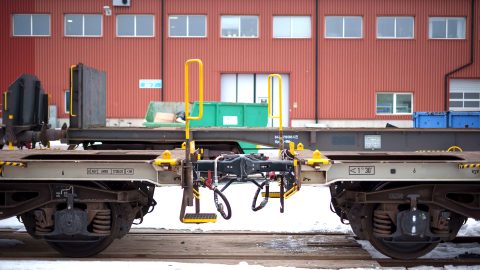JR East trials hydrogen locomotive from Tokyo to Kawasaki

Rail operator JR East has commenced trials of a hydrogen-powered train in Japan, the first such locomotive in the country. The trial will test the safety and performance characteristics of the new train and will involve a series of studies to be carried out on the Nanbu Line, running between Tokyo and Kawasaki.
“JR East is aiming to diversify its energy sources. Promoting the use of hydrogen is part of this effort. We have been proceeding with development of a fuel cell vehicle that uses hydrogen as an energy source,” a spokesperson for JR East commented. The 45-kilometer Nanbu Line connects Tokyo with Kanagawa Prefecture and runs from Tachikawa Station to Kawasaki Station.
Hybrid drive
The complex fuel cell system that powers the new locomotive has been jointly developed by JR East and technology partners Hitachi and Toyota. Building on Toyota’s previous experience creating fuel cell electric road vehicles, the partners have sought to fine tune its proton exchange membrane (PEM) fuel cell technology for use in rail operations.
A part of the proposed FV-E991 series, the new locomotive will be equipped with a hybrid system that uses a hydrogen fuel cell and a storage battery as its power sources. Instead of combusting fuel in air, the fuel cell system instead reacts hydrogen and oxygen within an electrolyte solution to generate electricity and produce water.
“The main circuit storage battery is charged by electric power from the fuel cell device and by capturing and converting energy to electric power using regenerative braking,” a spokesperson for Toyota explains. “The hybrid drive system supplies the electric power to the traction motors from both the fuel cell device and the main circuit storage battery, controlling the movement of the wheels.”
Hybrid drive system
Alongside the vehicle design and manufacturing expertise of JR East and Toyota’s PEM technology, the new locomotive will also benefit from Hitachi’s hybrid drive system, which allows the fuel cell to be supplemented by battery power. This will allow the train to reach a top speed of 100 kilometres per hour and to travel up to 140 kilometres on a single tank of hydrogen.
“Recently, progress is being made on the practical application of technologies for installing high-capacity lithium-ion batteries in rolling stock and using them for traction power. In particular, use of batteries in rolling stock that runs on non-electrified sections of track can save energy, minimize noise, and reduce maintenance requirements compared with conventional diesel railcars,” Yasuhiro Nagaura, Rolling Stock Electrical Systems Designer at Hitachi commented. “In the future, Hitachi will continue to meet a wide range of customer needs by drawing on the experience it has accumulated in battery-based technologies through its work on trains powered by batteries.”
High pressure capability
The train will be the world’s first locomotive capable of handling high-pressure hydrogen at 70 megapascals (Mpa).
“This enables long-distance rail travel that was difficult to achieve with 35 MPa fuel cell vehicles,” a spokesperson for JR East explains. “The configuration of this test train allows for field tests aimed at future commercialization and has specifications that could be easily applied to commercial use.”
The longer-range and potential pulling power of this system offers wide scope for deployment in rail freight operations, should initial tests prove positive, and although commercial services is not planned imminently, JR East expects that the new locomotive will ultimately replace its 440 diesel trains.
High anticipation
The project was first agreed in 2020 and has been driven by a desire to improve the environmental superiority of railways and deliver net zero operations.
“There is high anticipation for next-generation rolling stock that operates using clean energy, such as hydrogen,” Toyota states. “Hydrogen ensures minimal environmental impact as it does not emit any carbon dioxide when used as an energy source and it can be produced from various raw materials using renewable energy.”
You just read one of our premium articles free of charge
Want full access? Take advantage of our exclusive offer





